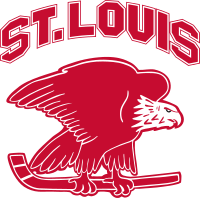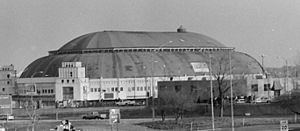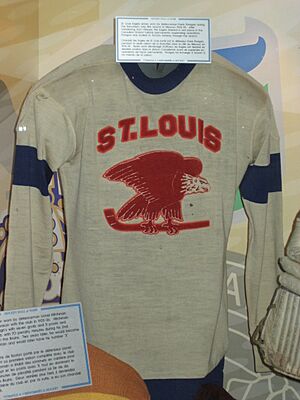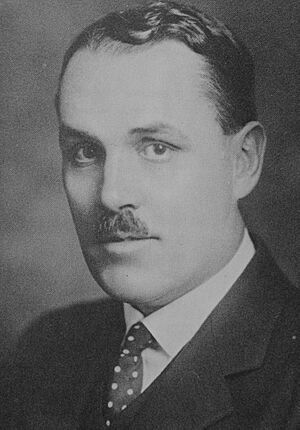St. Louis Eagles facts for kids
Quick facts for kids St. Louis Eagles |
|
|---|---|
 |
|
| Founded | 1883 |
| History | Ottawa Senators 1883–1934 St. Louis Eagles 1934–1935 |
| Home arena | St. Louis Arena |
| City | St. Louis, Missouri |
| Colors | Red, white, blue |
| Owner(s) | Ottawa Auditorium |
The St. Louis Eagles were a professional ice hockey team. They played in the National Hockey League (NHL). The team was based in St. Louis, Missouri. They played for only one year, during the 1934-35 NHL season.
The team started in 1883 as the Ottawa Senators. They were a very successful team. They joined the NHL as one of its first teams in 1917. But by the mid-1920s, the Senators faced money problems. Ottawa was the smallest market in the NHL. This made it hard for the team to make enough money.
Because of these money troubles, the Senators stopped playing for the 1931-32 NHL season. When they came back, they had sold their best players. This was an effort to raise funds. The Senators finished in last place for two seasons in a row. They kept losing money. After these bad seasons, the team decided it could not survive in Ottawa. They hoped to move to a bigger city.
To try and get back their money and pay debts, the Senators moved to St. Louis. They became the Eagles. However, the team still lost money. Travel costs were much higher in St. Louis. The Eagles had to sell more players to other teams. This helped them pay their bills.
After their only season, the owners asked the NHL to let them stop playing again. But the NHL said no this time. Instead, the league bought the team. They stopped its operations for good. The Eagles' players were then sent to other teams in the league.
Contents
History of the St. Louis Eagles
Moving from Ottawa
The Ottawa Senators began as an amateur club in 1883. They started paying their players in 1903. By 1907, they were a fully professional team. They were one of the first teams to join the National Hockey League (NHL) in 1917. The Senators won the Stanley Cup four times in the NHL's first ten years. They had won it seven times before the NHL even started.
However, Ottawa was the smallest city in the NHL. In 1931, Ottawa had only 110,000 people. This was about one-fifth the size of Toronto. Toronto was the NHL's second-smallest market. The Senators started having trouble getting fans to games. This happened when the NHL added teams in the United States in 1924. Games against these new American teams did not attract many people. Even though they won their last Stanley Cup in 1927, the team lost $50,000 that season.
The Senators asked the NHL if they could stop playing for the 1931-32 NHL season. This would help them pay off their debts. The league agreed. During this break, Ottawa received $25,000 for letting other teams use its players. The NHL also helped the team get a $28,000 loan. The Senators returned for the 1932-33 NHL season. They finished in last place. They finished last again in the 1933-34 NHL season. After that season, the Ottawa Auditorium, which owned the Senators, announced the team would move. They had lost $60,000 in the last two seasons. The owners said they needed to move the team to a bigger city. This would help protect their investors and pay off debts.
The Senators' owners decided to move the team to St. Louis, Missouri. The league approved this move on May 14, 1934. Thomas Franklin Ahearn stepped down as president. Redmond Quain took over. Quain moved the players' contracts and team operations to a new company. It was called the Hockey Association of St. Louis, Inc. Eddie Gerard was hired to coach the new team. The club was renamed the Eagles. This name was inspired by the logo of the Anheuser-Busch brewing company in St. Louis. The Senators' name and logo stayed in Ottawa. An amateur team used them until 1954.
At that time, St. Louis was the seventh-largest city in the United States. It had over 800,000 people. This was more than seven times larger than Ottawa. Even so, St. Louis had been denied an NHL team in 1932. Travel to the Midwest was thought to be too expensive during the Great Depression.
Before the Eagles even started playing, a problem came up. There was already a professional hockey team in St. Louis. They were the St. Louis Flyers. They played in the minor-pro American Hockey Association (AHA). The Flyers' owners said they had an agreement with the NHL. This agreement prevented the NHL from having a team west of the Mississippi River. They threatened to sue for $200,000 if the Eagles played their first game. After a visit from the AHA President, the Flyers were asked not to sue. The Flyers did not take further legal action. They eventually changed their home arena.
The 1934–35 Season

At this time, there were nine teams in the NHL. They were split into two groups: the Canadian and American. It made sense for the Eagles to be in the American Division. That division had teams like the Boston Bruins and Chicago Black Hawks. However, the Eagles kept the Senators' spot in the Canadian Division. This meant they played against teams like the Toronto Maple Leafs and Montreal Canadiens.
The main players from the Senators team returned. The Eagles played their games in the St. Louis Arena. This arena was built in 1929 for a dairy show. But it had struggled financially. In 1931, an ice hockey rink was added to attract new business. When the Eagles started playing, the St. Louis Arena became the only NHL stadium with separate seating for different races.
In their first game, the Eagles lost 3–1 to the Black Hawks. The Black Hawks were the defending Stanley Cup champions. The Eagles got their first win in the next game, beating the Rangers 4–2. After that win, the Eagles lost eight games in a row. After their first 13 games, the Eagles had won only 2 games and lost 11. They were last in their division. Coach Eddie Gerard quit. George "Buck" Boucher took over as coach. Boucher had been the coach of the Senators before Gerard.
Under Boucher, the team played better. They won 3 games, lost 3, and tied 3 in their next nine games. But the early losing streak had already hurt their fan base. Their first game had 12,622 fans. But attendance quickly dropped. In early 1935, the team cut ticket prices. They made them the lowest in the league to try and attract fans. By February, the team's money problems forced them to sell their top goal scorer, Syd Howe, to the Detroit Red Wings. Detroit received Howe and Ralph Bowman. In return, the Eagles got Teddy Graham and $50,000. This was a lot of money back then. Also, Frank Finnigan was sold to the Maple Leafs.
The Eagles could not keep up their early success under Boucher. They finished with the worst record in the league for the third year in a row. Their record was 11 wins, 31 losses, and 6 ties. They scored only 84 goals, which was the lowest in the league. Only the Montreal Canadiens allowed more goals that season (145) than the Eagles (144).
The End of the Eagles

By the end of the season, the Eagles' owners had lost $70,000. This was mostly because of the high cost of train travel. In those days, NHL teams traveled mainly by train. Since they were in the Canadian Division, the Eagles had many expensive trips to Montreal and Toronto. Selling some players helped them get $58,000. The owners hoped to move the team again to save it. Cleveland and even Ottawa showed some interest. But neither move happened.
So, the owners asked the NHL again to let them stop playing for a year. This time, the NHL refused. The Eagles team was put up for sale. No good offers came forward. The NHL then bought the team and its player contracts for $40,000. The league decided to play with only eight teams. If the NHL ever sold the team again, the money would go to the Ottawa Hockey Association.
The NHL gave the Eagles' players to other teams through a special draft. Teams with the fewest points from the previous season picked first. The Chicago Black Hawks did not take part in this draft. Eighteen of the 23 players were chosen. The remaining players were sent to minor leagues.
- New York Americans: Forwards: Pete Kelly, Eddie Finnigan
- Montreal Canadiens: Goaltender: Bill Beveridge, Defenseman: Irv Frew, Forwards: Paul Drouin, Henri Lauzon
- Detroit Red Wings: Forward: Carl Voss, Goaltender: William Peterkin
- New York Rangers: Forward: Glen Brydson, Defenseman: Vernon Ayres
- Montreal Maroons: Forward: Joe Lamb, Goaltender: Bill Taugher
- Boston Bruins: Forward: Bill Cowley, Defenseman: Teddy Graham
- Toronto Maple Leafs: Forwards: Gerry Shannon, Cliff Purpur, Jim Dewey, Defenseman: Mickey Blake
No serious offers to buy the team ever appeared. So, the Senators/Eagles team never played again. They are one of only two NHL teams to stop playing after winning a Stanley Cup. The other team was the Maroons.
In 1938, the Montreal Maroons tried to move to St. Louis. But the NHL said no. This was because of the high travel costs that had hurt the Eagles. The NHL finally returned to St. Louis in 1967. That year, the league doubled in size from the Original Six teams. The new team was named the Blues. They joined the Minnesota North Stars, Los Angeles Kings, Oakland Seals, Philadelphia Flyers, and Pittsburgh Penguins as part of the new 1967 NHL expansion.
Final Standings
| Team | GP | W | L | T | GF | GA | Pts |
|---|---|---|---|---|---|---|---|
| Toronto Maple Leafs | 48 | 30 | 14 | 4 | 157 | 111 | 64 |
| Montreal Maroons | 48 | 24 | 19 | 5 | 123 | 92 | 53 |
| Montreal Canadiens | 48 | 19 | 23 | 6 | 110 | 145 | 44 |
| New York Americans | 48 | 12 | 27 | 9 | 100 | 142 | 33 |
| St. Louis Eagles | 48 | 11 | 31 | 6 | 86 | 144 | 28 |
Note: W = Wins, L = Losses, T = Ties, GF = Goals For, GA = Goals Against, Pts = Points
Teams that qualified for the playoffs are highlighted in bold.
Players
Twenty-nine players played for the Eagles during their one season. The last player from the Eagles to still be active was Bill Cowley. He retired in 1947 after playing for the Boston Bruins. He was also the only player in the team's history to start his career with the Eagles and later be put into the Hockey Hall of Fame. Syd Howe was the only captain of the team. He and Bill Cowley were the only Eagles players to be inducted into the Hall of Fame. Pete Kelly was the last surviving St. Louis Eagle. He passed away in 2004.
Carl Voss led the team with 18 assists and 31 points. Howe led them in goal scoring with 14 goals. This was true even though he was traded during the season. These totals were much lower than the NHL leaders. Charlie Conacher of Toronto led the league with 36 goals and 57 points. Art Chapman of the Americans led in assists with 34. Bill Beveridge was the only goalie the team used that season. Out of his 11 wins, three were shutouts.
Here is a list of the players who played for the team:

| Player | Pos | GP | G | A | Pts | PIM |
|---|---|---|---|---|---|---|
| Oscar Asmundson | C | 11 | 4 | 7 | 11 | 2 |
| Vernon Ayres | D | 47 | 2 | 2 | 4 | 60 |
| Mickey Blake | LW/D | 8 | 1 | 1 | 2 | 2 |
| Ralph Bowman | D | 31 | 2 | 2 | 4 | 51 |
| Glen Brydson | RW | 48 | 11 | 18 | 29 | 45 |
| Gene Carrigan | C | 4 | 0 | 1 | 1 | 0 |
| Bud Cook | C | 4 | 0 | 0 | 0 | 0 |
| Bill Cowley | C | 41 | 5 | 7 | 12 | 10 |
| Ed Finnigan | LW | 12 | 1 | 1 | 2 | 2 |
| Frank Finnigan | RW | 34 | 5 | 5 | 10 | 10 |
| Irv Frew | D | 48 | 0 | 2 | 2 | 89 |
| Ted Graham | D | 13 | 0 | 0 | 0 | 2 |
| Syd Howe | C/LW | 36 | 14 | 13 | 27 | 23 |
| Frank Jerwa | LW/D | 16 | 4 | 7 | 11 | 14 |
| Walter Kalbfleisch | D | 3 | 0 | 0 | 0 | 6 |
| Max Kaminsky | C | 12 | 0 | 0 | 0 | 0 |
| Pete Kelly | RW | 25 | 3 | 10 | 13 | 14 |
| Joe Lamb | RW | 31 | 11 | 12 | 23 | 19 |
| George Patterson | W | 21 | 0 | 1 | 1 | 2 |
| Fido Purpur | RW | 25 | 1 | 2 | 3 | 8 |
| Vic Ripley | LW | 31 | 1 | 5 | 6 | 10 |
| Earl Roche | LW | 19 | 3 | 3 | 6 | 2 |
| Des Roche | RW | 7 | 0 | 0 | 0 | 0 |
| Gerry Shannon | LW | 25 | 2 | 2 | 4 | 11 |
| Carl Voss | C | 48 | 13 | 18 | 31 | 14 |
| Nick Wasnie | RW | 13 | 3 | 1 | 4 | 2 |
| Archie Wilcox | RW/D | 8 | 0 | 0 | 0 | 0 |
| Burr Williams | D | 9 | 0 | 0 | 0 | 6 |
- Goaltending
| Player | MIN | GP | W | L | T | GA | GAA | SO |
|---|---|---|---|---|---|---|---|---|
| Bill Beveridge | 2990 | 48 | 11 | 31 | 6 | 144 | 2.89 | 3 |
| Team: | 2990 | 48 | 11 | 31 | 6 | 144 | 2.89 | 3 |
All player stats taken from Hockey-Reference.com
Team Captains
- Syd Howe, 1934–35
See also
 In Spanish: Águilas de San Luis para niños
In Spanish: Águilas de San Luis para niños


